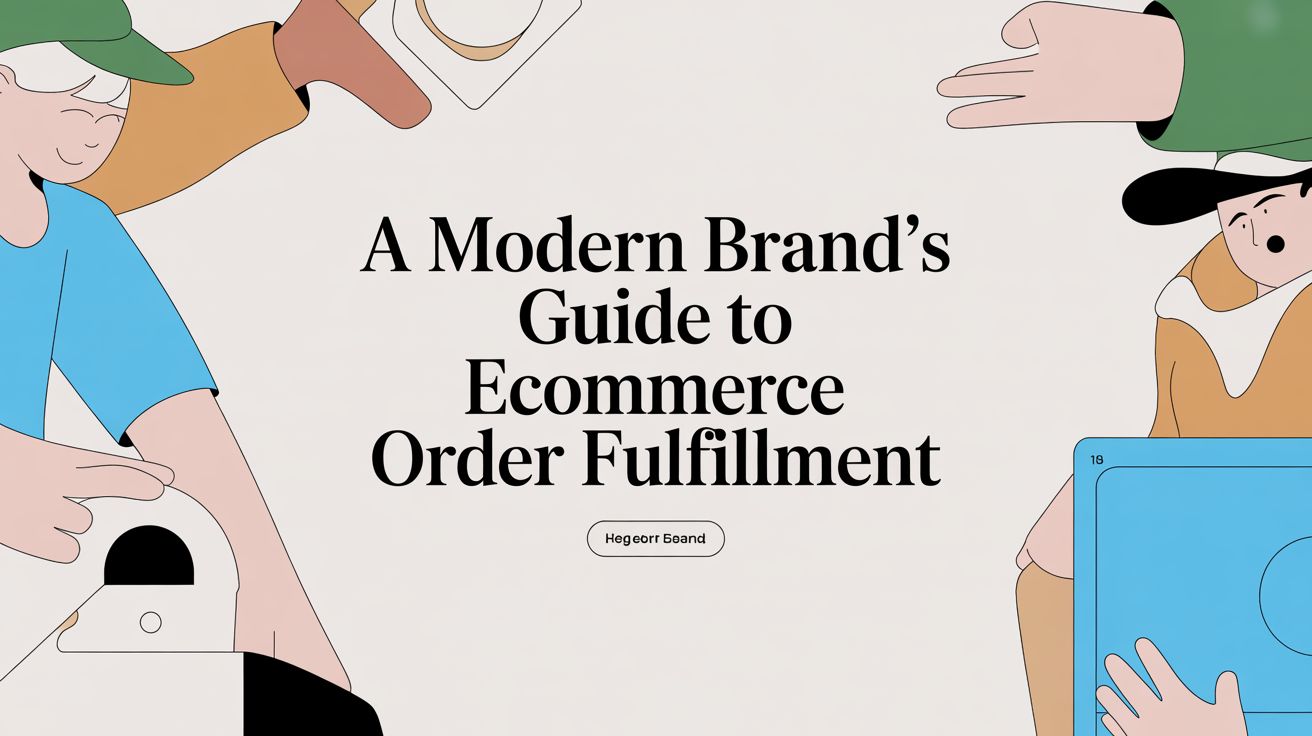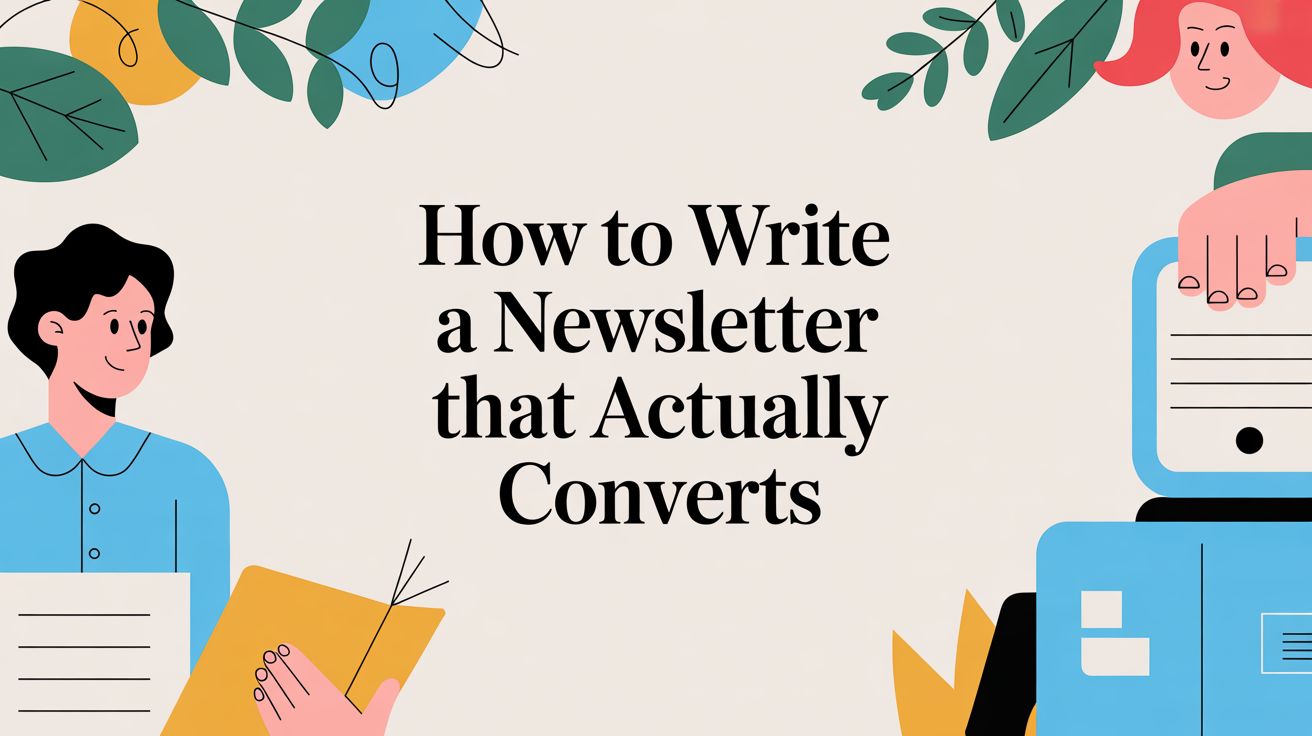
High-Impact Popups for Shopify That Convert
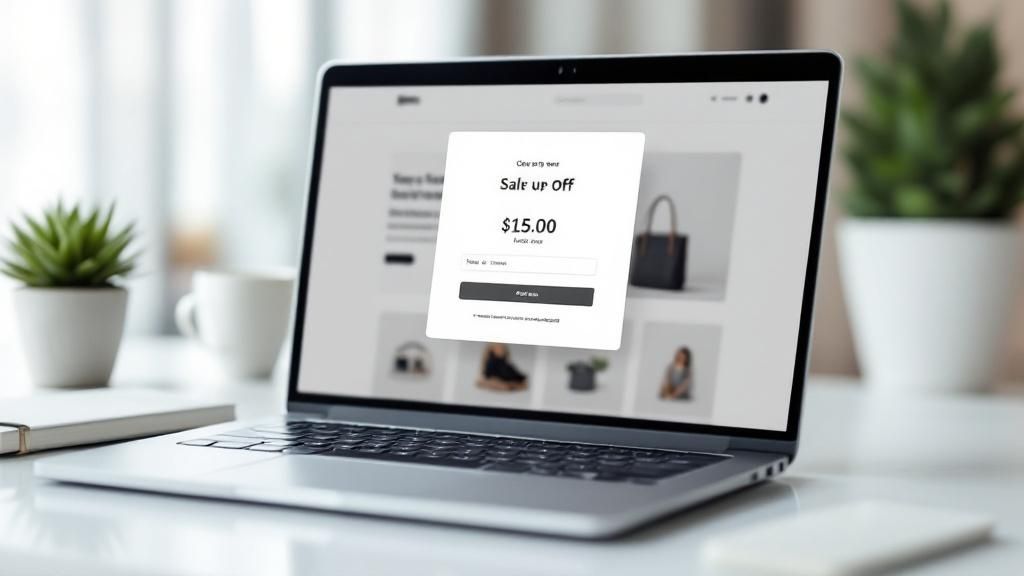
Most Shopify popups feel like a necessary evil. We set them up to grab an email or shout about a sale, but they often end up as just another digital flyer that shoppers instinctively close.
The truly effective ones? They're different. They're not just annoying interruptions; they are finely tuned instruments of behavioral science, built to guide customer decisions and directly boost your revenue. This goes way beyond simple lead capture.
The Psychology Behind Popups That Actually Work
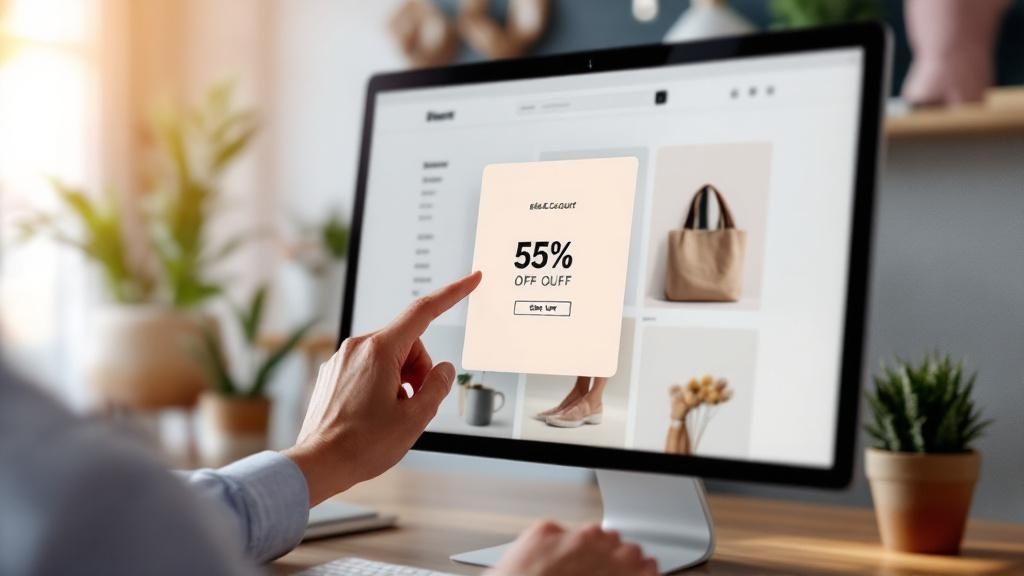
Most guides on this topic will tell you to jump straight into picking an app and tweaking the colors. That's putting the cart before the horse. Before you even think about design, you have to understand why a popup works in the first place.
A high-impact popup isn’t about flashy graphics or aggressive timing. It's about tapping into the fundamental psychological triggers that drive human action. Without this foundation, you’re just adding another annoying box to your site that people will race to close.
The real difference between a popup that gets ignored and one that generates instant sales is its ability to spark an emotional response—one grounded in proven consumer psychology. This is where the science of urgency marketing pulls away from just slapping a basic countdown timer on an offer.
Tapping into Core Behavioral Drivers
Effective urgency isn't about creating fake pressure. It’s about aligning your offers with the natural, almost subconscious patterns of human decision-making. The goal is to nudge a passive browser into becoming an active, committed buyer by making your offer feel timely, relevant, and too good to pass up.
Here are the key psychological drivers you should be using:
- Scarcity: This is a cornerstone of behavioral economics. People simply place a higher value on things they think are limited. A popup that flashes "Only 15 left in stock!" is miles more compelling than a generic "10% Off" banner because it introduces the possibility of loss.
- Fear Of Missing Out (FOMO): We've all felt it. FOMO is that nagging anxiety that you might miss out on a great experience. Popups announcing a flash sale ending at midnight or an exclusive product drop for the next 24 hours tap directly into this incredibly powerful motivator.
- Social Proof: We're social creatures. We look to others to see what we should do, especially when we're unsure. A popup that says, "Over 500 people have bought this today" is powerful validation. It eases purchase anxiety and makes shoppers want to join the in-crowd.
- Anticipation: The buildup can be just as powerful as the event itself. A "coming soon" popup that lets people sign up for early access creates a feeling of exclusivity and gets them primed to buy the second the product drops.
Actionable Takeaway: Ground your next campaign in one of these principles. Instead of a generic "Sale" popup, try one that highlights limited stock (Scarcity) or shows how many people are currently viewing an item (Social Proof). The shift from a passive message to an active psychological trigger is what drives revenue.
This is the core philosophy behind Quikly's approach. We build sophisticated, automated "Moments" that use these deep psychological triggers to drive real revenue, not just collect a few emails.
You can go deeper on these concepts by exploring these insights on the psychology of urgency marketing. It's all about building a smarter system—one that understands customer behavior and responds with perfectly timed, psychologically resonant offers.
Choosing the Right Shopify Popup App
Picking the right app for your Shopify popups is one of those decisions that can directly move the needle on your revenue. A basic tool might grab a few emails here and there, sure. But a more sophisticated platform can become a core piece of your growth engine. The real choice is about moving beyond simple, generic features and focusing on capabilities that create personalized, psychologically-timed experiences for your shoppers.
The difference between an app that just sits there and one that actually drives profit is its intelligence. Can it tell the difference between a first-time visitor and a loyal customer who's back for their fifth purchase? Can it trigger a specific, high-value offer only when a cart value tips over $150? These aren't just flashy features; they're revenue-generating strategies that protect your margins by stopping you from giving away unnecessary blanket discounts.
Beyond Basic Email Capture
Real growth comes from apps that understand and react to shopper behavior in the moment. Instead of just blasting a popup at everyone after ten seconds, you need to look for advanced behavioral triggers.
- Exit-Intent Technology: This is non-negotiable. It senses when a user is about to click away and presents a compelling reason to stick around—maybe a last-chance discount or a reminder about their cart. Think of it as your digital safety net for recovering sales that would have otherwise vanished.
- Scroll-Depth Triggers: This lets you show an offer only after a visitor has proven they're interested by scrolling a certain percentage down the page. It’s a much classier approach than interrupting them right away.
- Cart-Value Targeting: This is how you get smart with your discounts. You can create special offers just for your high-value shoppers, protecting your bottom line by not giving away a 15% discount on a $20 order.
Getting your popup strategy right can have a massive impact on your store's key metrics.
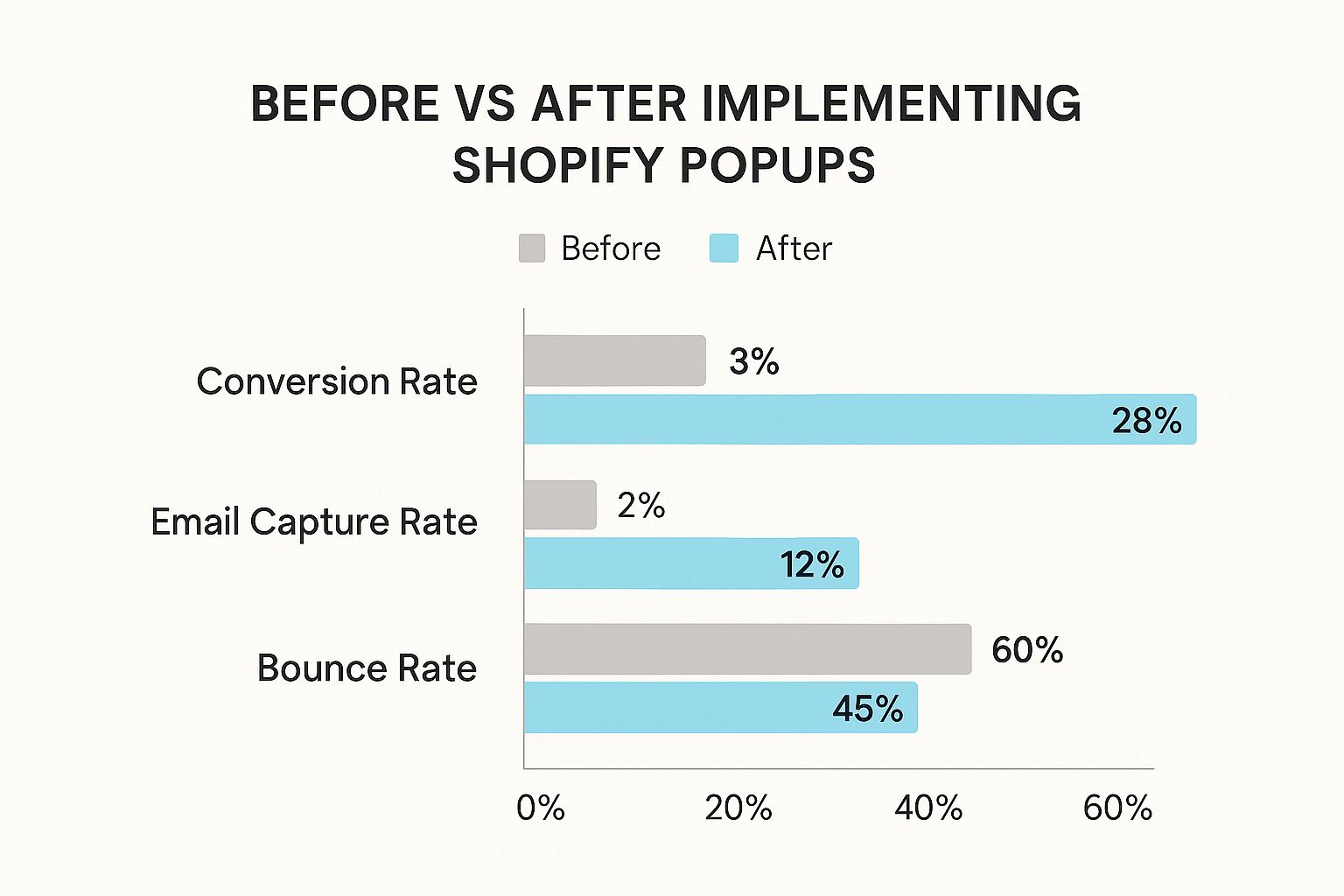
As you can see, a well-thought-out approach can seriously boost conversions and email signups while cutting down on how many people bounce from your site.
Essential Shopify Popup App Features
When you're comparing apps, it’s easy to get lost in a long list of features. I've found it's better to think about them in terms of what they actually do for your business. This table breaks down the must-have functionalities by their primary impact.
| Feature Category | Specific Functionality | Primary Business Impact |
|---|---|---|
| Audience Targeting | New vs. Returning Visitors, Geolocation, Referral Source | Delivers highly relevant offers, increasing conversion rates. |
| Behavioral Triggers | Exit-Intent, Scroll Depth, Time on Page, Cart Value | Recovers abandoned carts and engages users at peak interest. |
| Customization | Visual Editor (Drag-and-Drop), Custom Fields, Mobile-Responsive | Maintains brand consistency and optimizes user experience. |
| Integrations | Email Service Providers (e.g., Klaviyo), SMS Platforms, CRM | Automates marketing workflows and creates a unified customer view. |
| Performance Analytics | A/B Testing, Conversion Tracking, View-Through Rates | Provides data-driven insights to continuously improve results. |
Ultimately, these features work together to turn a simple popup into a dynamic tool that adapts to each unique visitor, which is where the magic really happens.
Evaluating Integration and Scalability
Your popup app can't be an island. It absolutely has to integrate seamlessly with the rest of your marketing stack. Make sure it connects flawlessly with your email platform like Klaviyo and any SMS marketing tools you're using. This creates a smooth flow of customer data, which is essential for building out powerful, automated marketing sequences.
When you're looking for the right tool, also consider robust e-commerce survey software that includes flexible popup features—it can be a great way to consolidate tools. For Shopify Plus merchants, the app's ability to handle high traffic without slowing down your site is crucial.
While the average Shopify store conversion rate hovers somewhere around 2.5%, a great popup strategy can push that number much higher. I’ve seen stores hit conversion lift numbers as high as 9.28% by implementing smart, targeted popups.
Actionable Takeaway: Review your current marketing tech stack. Does your popup tool integrate directly with your primary email or SMS provider (like Klaviyo)? If not, you're creating manual work and missing out on powerful automation opportunities. Make seamless integration a non-negotiable feature in your next tool evaluation.
In the end, choosing the right tool is an investment in a solution that will grow alongside your business. Find one that fits where you are now but also has the advanced capabilities you’ll need down the road. For a deeper look at other tools that can really boost your marketing, check out our guide on the best Shopify marketing apps.
Designing Popups That Convert Without Annoying Shoppers
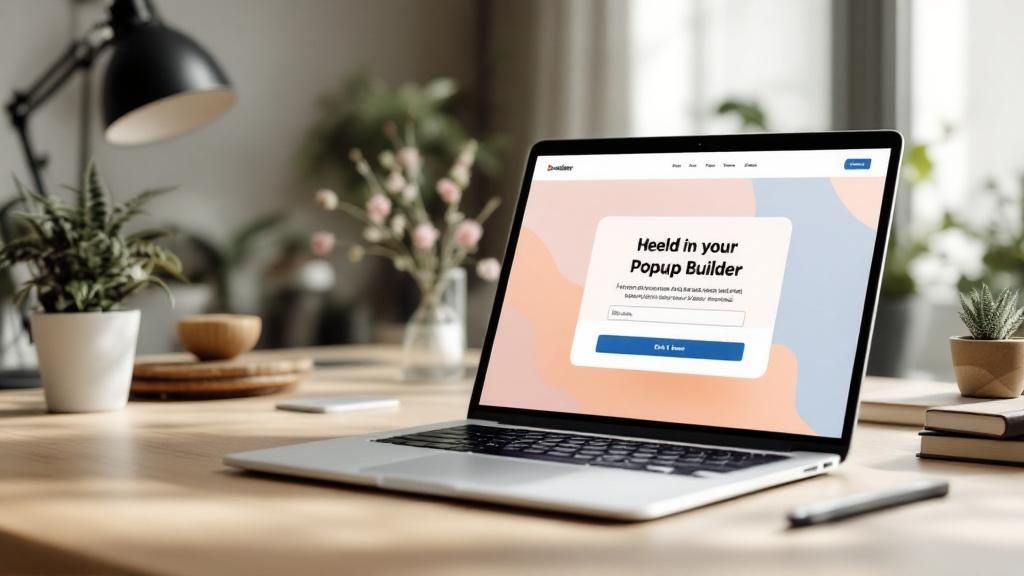
We've all been there. You land on a site, and before you can even get your bearings, a clunky, off-brand popup takes over your screen. It’s an instant turn-off.
A badly designed popup is more than just annoying; it’s a direct hit to your brand’s credibility and a surefire way to send potential customers running. The real goal isn't to interrupt the shopping experience. It's to slide in a valuable, timely offer that feels like a helpful and natural part of their visit.
Finding that sweet spot comes down to a careful mix of visual appeal, punchy copy, and a call-to-action (CTA) that’s impossible to ignore. Every detail, from the font you choose to the color of the button, needs to feel like you to build trust and get that click.
Crafting a Visually Seamless Experience
Your popup should feel like it belongs on your site, not like some third-party ad that just crashed the party. Brand consistency is everything. It reinforces recognition and sends a subconscious signal to the shopper that this offer is legit and comes straight from you.
So, how do you get there? Dial in these key design elements:
- Brand-Aligned Visuals: Use the exact same color palette, fonts, and logo that you have across your Shopify store. This creates a cohesive, trustworthy look.
- High-Quality Imagery: If your popup features a product, don’t skimp on the photo. Use a professional, high-res image that makes the item look irresistible.
- Clear Visual Hierarchy: What's the most important thing? The offer, right? Make it the most prominent element. Use size, color, and placement to guide your shopper's eye from the headline straight to that CTA button.
It's also worth remembering that popups are technically modal dialogs. Getting familiar with accessible design principles for dialog modals is a game-changer for ensuring usability and preventing frustration. If a shopper can't figure out how to close your popup, you've created friction—and friction is the enemy of conversion.
Writing Copy That Inspires Action
The design grabs their attention, but it's the copy that closes the deal. Your message needs to be crystal clear, super concise, and all about what's in it for the customer.
Ditch generic phrases like "Sign up for our newsletter." That's all about you. Instead, flip the script and shout the value from the rooftops.
Actionable Takeaway: Audit your main popup's headline and CTA right now. Does it lead with a benefit for the customer? Change "Sign Up for Updates" to "Get 15% Off Your First Order." Shift "Submit" to "Claim My Discount." This simple change in perspective can dramatically increase engagement.
The CTA button is the grand finale. This is where you seal the deal. Use strong, action-oriented words that create a sense of urgency and excitement. Phrases like "Claim My Discount," "Unlock My Offer," or "Shop Now" work so much better than a boring "Submit."
And please, make the button pop. It should be visually distinct and easy to tap, especially on a phone. Every single popup for Shopify absolutely must be mobile-responsive. With most traffic coming from mobile, frustrating those users is a mistake you just can't afford to make.
Launching Your First Revenue-Driving Popup Campaigns
Theory and design are great, but action is what generates revenue. This is where we put those psychological principles to work and translate them into a measurable ROI. Forget the one-size-fits-all popups that annoy visitors. We're going to focus on three specific, high-impact blueprints you can roll out on your Shopify store today.
Each of these campaigns is built to do more than just snag an email address. They're designed to influence a purchase at the most critical moments in a customer's journey. This is the real difference between a basic popup app and a smart urgency marketing platform like Quikly that uses sophisticated automation to generate revenue.
The Cart Abandonment Savior (Exit-Intent Offer)
With the industry average cart abandonment rate sitting at a jaw-dropping 70%, an exit-intent campaign isn't just a nice-to-have. It's your first line of defense against bleeding revenue. This popup only triggers when a shopper with items in their cart moves their cursor to leave your site, catching them right at that moment of hesitation.
That hesitation is a golden opportunity. The shopper is clearly interested, but something is holding them back—usually sticker shock from the price or unexpected shipping costs. A perfectly timed offer can be just the nudge they need.
- The Offer: Don't just throw a generic discount at them. Get specific and make it compelling. "Complete your order now and get 15% off" is a decent start, but "Wait! Get free shipping on your order—just for today" often works wonders. Unexpected shipping fees are a notorious deal-breaker.
- Targeting: This is key. Set the trigger to exit-intent and the audience to visitors with items in their cart. For Shopify Plus merchants, you can get even smarter by targeting carts over a certain value (say, $100) to protect your margins on smaller sales.
The First-Impression Converter (Welcome Discount)
When a new visitor lands on your Shopify store, you're at a critical decision point. They don't know your brand, and you haven't earned their trust yet. A welcome popup is your chance to make a fantastic first impression, offer instant value, and turn a casual browser into a first-time customer.
This isn’t just about growing your email list; it's about kicking off a transaction. By giving them a little something for their first purchase, you lower the barrier to entry and start building that crucial customer relationship from day one.
Key Insight: A welcome offer taps into the powerful principle of reciprocity. When you give a new visitor a valuable discount right away, they feel a subtle psychological pull to give something back—in this case, their business.
- The Offer: A percentage-based discount like "Get 10% Off Your First Purchase" is a classic for a reason. It’s simple, easy to understand, and has universal appeal.
- Trigger & Targeting: You don't want to be too aggressive. Set this to trigger after a user has been on the site for 10-15 seconds or scrolled 30% of the page. This gives them a moment to get a feel for your brand before you present the offer. Make sure to target new visitors only to avoid giving away discounts to your loyal, returning customers.
The Engagement Booster (Gamified Popup)
Sometimes the goal is simply to create a memorable, fun interaction that boosts engagement while growing your marketing lists. This is where gamified popups, like a "spin-to-win" wheel, absolutely shine. They tap into our natural love for games and the thrill of winning something.
This simple switch transforms the boring act of signing up for a newsletter into an exciting event. The best part? The prize feels more valuable to the user simply because they "won" it.
- The Prizes: Load the wheel with a good mix of offers to make it more enticing. You'll want a high-value grand prize (25% off, for instance), several solid mid-tier prizes (10% off, free shipping), and a few smaller but still valuable outcomes (like a free gift with purchase).
- Implementation: Trigger this for both new and returning visitors who haven't subscribed yet. This can be integrated directly with your email and SMS platforms like Klaviyo, automatically dropping new contacts into the right marketing flows without you lifting a finger.
Optimizing Popup Performance with Data-Driven Insights
Getting your first Shopify popups live isn't the finish line; it's the starting block. The real, sustainable growth comes from digging into the data and constantly tweaking your approach. This is how you turn educated guesses into a high-performance system that actually adapts to your customers.
To get there, you have to look past vanity metrics like impressions. The focus needs to be on performance indicators that have a direct line to your bottom line. These are the numbers that tell you if your popups are actually changing shopper behavior and making you money.
Tracking the Metrics That Matter
Think of your Shopify popup app's dashboard as more than just a settings panel—it's a goldmine of actionable data. To make any sense of it, you need to zero in on the key performance indicators (KPIs) that reveal the true health of your campaigns.
I always start by tracking these essentials:
- View Rate: What percentage of targeted visitors actually saw the popup? A low view rate is a red flag that your trigger rules might be too tight or just firing at the wrong moment.
- Click-Through Rate (CTR): Of those who saw the popup, how many clicked your call-to-action? This is a direct measure of how compelling your offer and design really are.
- Conversion Rate: This is the big one. What percentage of people who clicked the popup actually completed the goal, whether that was making a purchase or signing up for your list?
The data doesn't lie: popups are still a powerhouse tool for Shopify stores. The average conversion rate for popups is sitting around 4.65%, a solid jump from the previous year, which shows just how effective they continue to be. You can discover more insights on popup performance to see how your own campaigns stack up against the benchmarks.
The Power of A/B Testing
Relying on gut feelings alone is one of the most expensive mistakes you can make. A/B testing, or split testing, is the only reliable way to find out what truly clicks with your audience. The method is simple: run two versions of a popup at the same time to see which one performs better against a specific goal, like a higher click-through rate.
By methodically testing one variable at a time—the headline, the offer, the button color, or even the timing—you can make incremental improvements that lead to significant revenue lifts over time. It removes the guesswork and replaces it with certainty.
But don't just test random things. Focus on the high-impact elements first. A test between a "15% off" offer versus a "Free Shipping" offer will likely tell you a lot more than changing a button from blue to green. The insights you get are invaluable, helping you understand the science behind data analytics and what truly makes your customers take action.
Advanced Segmentation for Maximum Relevance
Once you've got some data flowing in, you can graduate to more advanced tactics like audience segmentation. A one-size-fits-all popup will never be as effective as a message tailored to a specific group of shoppers. The end goal is to make every interaction feel personal and relevant.
Try creating unique popup campaigns for different segments:
- Traffic Source: A visitor from a TikTok ad probably has different expectations than someone who Googled a specific product. Tailor the offer to match their journey.
- Customer History: Show a special "welcome back" discount to returning customers, while brand new visitors see your standard welcome offer.
- On-Site Behavior: If a shopper has viewed three items in your "New Arrivals" collection, why not trigger a popup with a special offer on those very products?
This level of personalization is what separates a basic popup tool from a sophisticated urgency marketing platform. By delivering the right message to the right person at the right time, the popup becomes a welcome and helpful part of their shopping journey—dramatically increasing its profitability.
Common Questions (and Expert Answers) About Shopify Popups
When you start digging into the world of Shopify popups, a few questions always bubble to the surface. It's totally normal. Getting clear, practical answers is the only way to build a strategy that actually drives revenue without driving your customers crazy.
Let's tackle some of the most common concerns I hear from merchants.
Will Popups Wreck My Site Speed and SEO?
This is probably the #1 concern, and for good reason. A clunky, poorly coded popup app can absolutely slow your site down. And we all know site speed is a huge deal for both user experience and your Google rankings.
But here’s the thing: a modern, well-built popup solution is designed specifically to avoid this. They're built to be lightweight and load asynchronously. In simple terms, this means the popup doesn't get in the way of your main page content loading first.
When you're shopping for a popup app, look for ones that talk a big game about performance and having a minimal impact on your store’s speed. Then, put them to the test. Always run a site speed check before and after you install anything.
How Often Should I Actually Show Popups?
There's a razor-thin line between being helpful and being flat-out annoying. Blasting a visitor with the same popup on every single page they visit is the fastest way to make them hate your brand. This is where smart frequency rules become non-negotiable.
A solid rule of thumb is to set your display rules so a visitor won't see the same popup again for at least 14 to 30 days after they've closed it.
Better yet, sophisticated platforms give you much deeper control. You should never, ever show a first-time-visitor welcome offer to a loyal customer who has already bought from you ten times. Context is everything.
Are Popups Just for Capturing Emails, or Can They Actually Make Sales?
This is a huge one. It's a common myth that popups are just for building your email list. While they’re great for that, thinking of them only as lead capture tools is leaving a ton of money on the table.
The real power is in using them to drive sales directly. The difference is all in the strategy.
Think about it: an exit-intent popup that offers free shipping to someone with a full cart isn't a lead magnet—it's a sales closer. Or a popup that appears on a product page highlighting a flash sale on that exact item? That’s using scarcity to get an immediate conversion.
The goal shifts from just growing a list to generating immediate ROI. This is the core difference between a basic popup builder and a true urgency marketing platform. By matching your offers to critical moments in the buying journey, you’re not just collecting contacts; you're directly influencing purchase decisions and boosting your bottom line.
Ready to stop using basic popups and start implementing intelligent, revenue-driving urgency marketing? See how Quikly uses the science of consumer psychology to turn casual browsers into confident buyers. Discover how Quikly works.

The Quikly Content Team brings together urgency marketing experts, consumer psychologists, and data analysts who've helped power promotional campaigns since 2012. Drawing from our platform's 70M+ consumer interactions and thousands of successful campaigns, we share evidence-based insights that help brands create promotions that convert.
